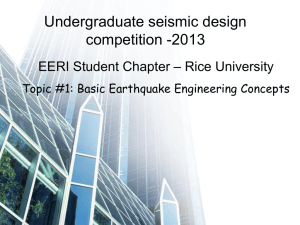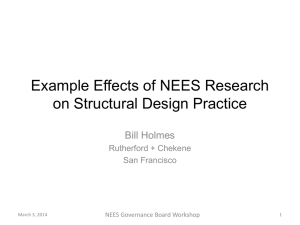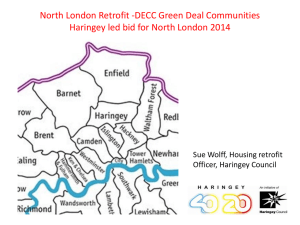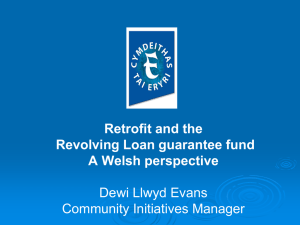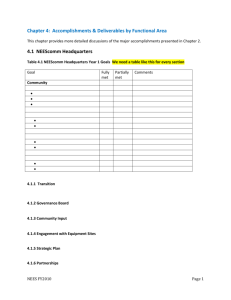The NEES-Soft Project
advertisement
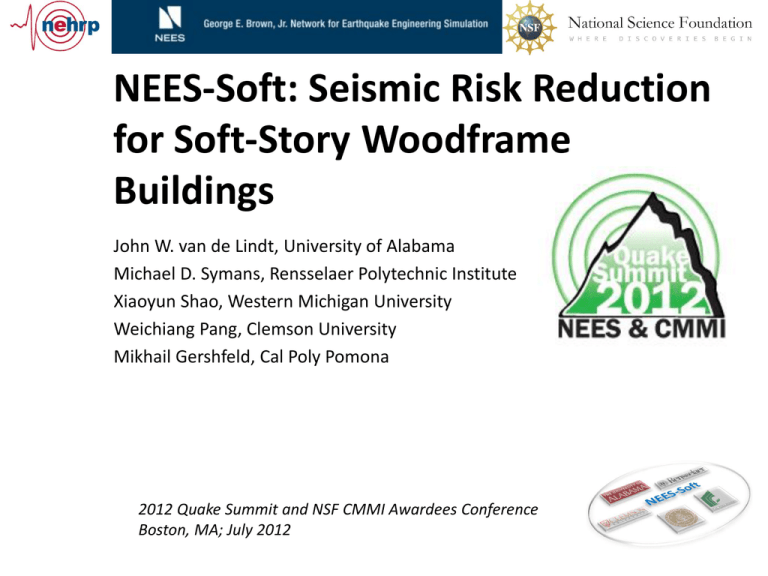
NEES-Soft: Seismic Risk Reduction for Soft-Story Woodframe Buildings John W. van de Lindt, University of Alabama Michael D. Symans, Rensselaer Polytechnic Institute Xiaoyun Shao, Western Michigan University Weichiang Pang, Clemson University Mikhail Gershfeld, Cal Poly Pomona 2012 Quake Summit and NSF CMMI Awardees Conference Boston, MA; July 2012 The NEES-Soft Project Team University of Alabama: Prof John W. van de Lindt; Pouria Bahmani, Ph.D. Student Clemson University: Prof WeiChiang Pang; Ershad Ziaei, Ph.D. Student Western Michigan University: Prof Xiaoyun Shao; Chelsea Griffith, M.S. Student Rensselaer Polytechnic Institute: Prof Michael D. Symans, Prof David V. Rosowsky; Jingjing Tian, Ph.D. Student Cal Poly – Pomona: Prof Mikhail Gershfeld; Robert McDougal. M.S. Student; Nathan Summerville, B.S. Student SUNY at Buffalo: Prof Andre Filiatrault Structural Solutions Inc.: Gary Mochizuki U.S. Forest Products Lab.: Douglas Rammer Tipping Mar: David Mar South Dakota State University: Prof Shiling Pei Cal Poly – SLO: Charles Chadwell The NEES-Soft Practitioner Advisory Committee (PAC) Laurence Kornfield Kelly Cobeen Steve Pryor Tom Van Dorpe Doug Thompson Doug Taylor Janielle Maffeti Rose Grant City of San Francisco - CAPSS WJE Simpson Strong Tie VanDorpe Chou Associates, Inc. STB Structural Engineers Taylor Devices California Earthquake Authority State Farm Research Motivation for NEES-Soft Community Action Plan for Seismic Safety (CAPSS) 43 to 80 percent of the multi-story woodframe buildings will be deemed unsafe after a magnitude 7.2 earthquake 25% of these buildings would be expected to collapse Thousands of these buildings exist, many of them multi-family rentals ATC 71.1 Project Develop seismic retrofit requirements for soft-story wood-frame buildings in seismically active regions of the United States Focusing primarily on Northern and Southern California and the Pacific Northwest NEES-Soft Project Summary NEES-Soft: Seismic Risk Reduction for SoftStory Woodframe Buildings Five-university-industry National Science Foundation-funded collaboration Develop a better understanding the behavior of soft-story woodframe buildings under seismic loads through numerical analyses and experimental testing Provide experimental validation of ATC 71.1 concepts and PBSR approaches Characterize the improvement in seismic performance for an array of force-based and performance-based retrofit techniques Develop improved models of woodframe collapse mechanisms to better estimate the margin against collapse. NEES-Soft Retrofit Testing NEES@UB Rxn Wall 7 months beginning April 2013 Full-scale slow pseudodynamic test Six actuators (6 DOF) One 2-bedroom apartment per floor Level 1 – two-car garage and storage space Floor Plans First Floor H: Horizontal Wood Sheathing G: Gypsum Wallboard Ground Floor Plan 3'-0" 8'-0" 3'-0" NEES-Soft (11.19.2011) 10'-8" 3'-4" H,G H,G 4" 1 Rev. 4-2 H,G G,G H,G EQx G,G H,G H,G 3 8'-0" EQx 8'-0" 24'-0" 2 H,G H,G H,G H,G H,G 4 7'-0" 1'-6" 1'-6" 1'-6" 7'-0" 10'-0" 10'-0" Y X A B C Floor Plans Typical Floor H: Horizontal Wood Sheathing G: Gypsum Wallboard Typical Floor Plan 3'-0" Rev. 4-2 14'-0" 3'-0" 3'-112" H,G Bdrm 2 9'-2" G,G 3'-0" 3'-0" 2 9'-4" G,G 6'-0" 5'-6" 8'-0" EQx G,G 4" 7'-0" H,G Kitchen H,G G,G G,G 3'-0" 6'-4" 5'-6" 8'-0" Bath Living Room H,G H,G G,G 7'-0" 1'-0" G,G 3 2'-0" 4'-8" 8'-0" 24'-0" G,G Bdrm 1 G,G 4'-0" 4 1'-6" EQx 3'-0" 1'-10" H,G H,G 1 NEES-Soft (11.19.2011) H,G H,G 1'-6" 7'-0" 3'-0" 10'-0" H,G 7'-0" 1'-6" 10'-0" 20'-0" Y X A B C Seismic Retrofits for the NEES-Soft Building Phase 1– steel base frame Retrofit Type Target Verification Steel Special Moment Frame (SSMF) ATC 71.1 or Inverted Moment Frame (IMF) Wood Shear Walls SSMF/IMF and Wood Shear Walls Cross Laminated Timber (CLT) Performance-Based Seismic Retrofit Dampers Phase 2 – first story constructed Retrofit Type Steel Special Moment Frame (SSMF) or Inverted Moment Frame (IMF) SSMF/IMF and Wood Shear Walls Knee-brace Target Verification ATC 71.1 Performance-Based Seismic Retrofit Other (only a limited numerical prediction being performed) NEES-Soft PSD and Real-time tests @UA Test Objectives: – to verify the developed psudodynamic (PSD) testing and hybrid testing methods and their application to wood frame structures for eventual expansion to full buildings at NEES@UB (completed) The first time hybrid testing of a wood frame structure. – to characterize the highly nonlinear seismic behavior of woodframe construction (underway) – to evaluate in real earthquake rate the enhanced seismic behavior of woodframe installed with viscous dampers (underway) NEES-Soft PSD hybrid and Real-time tests @UA – Cyclic Tests: full CUREE protocol – Open Loop Hybrid Tests • to determine slow testing rate: 20 times slower was selected • to verify the developed continuous loading method – Closed Loop Hybrid Tests • Specimen 1: Loma Prieta Capitola (Completed) – Test 1: 72 year – Test 2: 2500 year – Test 3: mass x 3 and 2500 year • Specimen 2: Northridge-Beverly Hills (to be complete by Shao @ WMU remote control UA hybrid testing controller) Test Setup - Slow Pseudo Dynamic and Real-time Cyclic test (CUREE Protocol) - Photos Slow Pseudo Dynamic test UA Hybrid Testing Results First Floor Wall HysteresisSlow Hybrid Test 10 Test 3, 2500yr x3 mass Test 2, 2500yr Test 1, 72yr 8 6 Force(kip) 4 2 0 -2 -4 -6 -8 -10 -6 -5 -4 -3 -2 -1 Displacement(in) 0 1 2 3 Slow PSD hybrid test @UB NEES Objective : to develop an increased understanding of – – – – the effects of first floor (soft-story) retrofits on the upper stories Specimen: 3-dimensional (near) full scale model with and without retrofit Numerical substructure: existing first story with various retrofits Physical substructure: upper stories, full representation with construction details Use six actuators to consider rotation Conceptual plot of PSD hybrid test @ UB Performance-Based Retrofit using Energy Dissipation System •Performance-Based Retrofit • Increase damping in first story (and possibly stiffness) • May increase force transmitted to upper stories (imposes limit on magnitude of damping in first story) • Expected performance level for design earthquake: Fully Operational (FO) to Immediate Occupancy (IO) • Energy Dissipation System • Linear fluid viscous dampers • Peak force out-of-phase with peak displacement • Previously tested in wood structures • Location of Dampers • First story only • Along perimeter walls to provide contribution to torsional resistance • Along both stiff and flexible wall lines • Displacement amplification system employed (scissor-jack) Parametric Study of One-Story Inelastic Structure with Energy Dissipation System - Two-way asymmetric w/rigid diaphragm - Biaxial ground motion - CR and CM are fixed - CSD varied EQ-Y EQ-X EQ Motions - Canoga Park Station (moderate far-field) - Far-field EQ records from ATC-63 - Stronger component applied in X-direction - 4 walls (one on each side) - Wall materials: Exterior: Horiz. wood sheathing Interior: Gypsum wall board - 2 dampers along X- direction, (one each on north and south sides) - 2 dampers along Y- direction, (one each on west and east sides) SAWS Shear Wall Model: Hysteretic response of conventional structure (no dampers) subjected to bi-axial Canoga Park motion. CM = Center of Mass CR = Center of Rigidity (located at ex / a 0.2 and ey / d 0.2 ; similar to location for NEES-Soft test specimen) CSD = Center of Supplemental Damping (location varies in X- and Y-direction). 20 Effect of Damper Location (CSD) on Max. Inter-Story Drift - One-story inelastic structure (Tnx = Tny = 0.5 sec) - Biaxial ground motion (CP106+CP196) - Fixed total damping magnitude: Damping coefficient along each direction is 5 kips-sec/in Conventional 0.77 (0.2,-0.2) Moving CSD from CR towards, and beyond, CM: - The maximum structural responses generally decreases (reducing translation AND torsion). - Damper location (plan-wise distribution) has strong influence on structure response. - For a range of ground motions, the optimized CSD location is approximately at the coordinate (0.2, -0.2), which is symmetric with CR about CM. 21 DDD from previous work Pang et al, 2010 CM & CR CM & CR Z Y X DDD with Torsion Procedure: Linear system (i.e. stiffness of lateral load resisting system element does not change during the analysis) Decoupling torsional modes from translational modes Modal analysis for decoupled modes Combining modes to obtain the total displacement Using spectral displacement to find the design stiffness of each lateral load resisting element Nonlinear system Using equivalent secant stiffness and damping ratio using method proposed by Filiatrault and Folz Regular building with Large in-plane Eccentricities Stiffness ratio over the height: K3 = 1.75 K; K1 / K2 = 1.11 K2 = 2.25 K; K2 / K3 = 1.29 K1 = 2.5 K; Eccentricity ratio: ex = 4.82 ft ; Lx = 30 ft ex / Lx = 16.1% ey = 4.29 ft; Ly = 20 ft ey / Ly = 21.4% er = 6.45 ft CM ey CR Unit weight for each floor: 30 psf Earthquakes at MCE level (San Francisco) EQ forces applied in X-direction Target Drift = 2% for Prob. of NonExceedance of 50% Tn = 0.577 sec. Sa = 1.44g Probability of Exceedance ex 1st Story Target = 2.0% Error (%) = 2.5% 2.05% Inter-story Drift Ratio (%) Soft-story Building with Irregularity over the height and in-plane Stiffness ratio over the height: K3 = 1.8 K; K1 / K2 = 0.77 K2 = 2.6 K; K2 / K3 = 1.44 K1 = 2.0 K; Eccentricity ratio for all stories: ex = 3.75 ft ; Lx = 30 ft ex / Lx = 12.5% ey = 3.33 ft ; Ly = 20 ft ey / Ly = 16.7% er = 5.02 ft CM CR ey ex Earthquakes at MCE level (San Francisco) EQ forces applied in X-direction Target Drift = 2% for Prob. of NonExceedance of 50% Tn = 0.489 sec. Sa = 1.5g Probability of Exceedance Unit weight for each floor: 30 psf 1st Story 1.93% Error (%) = 3.5% Target = 2.0% Inter-story Drift Ratio (%) Summary Eccentricity Fundamental ex/Lx ey/Ly Period (sec) Sa @ MCE (%) (%) Regular Building with Large in-plane Eccentricity 16.1 21.4 0.577 1.44g Building Soft-story Building with in-plane Eccentricity 12.5 16.7 0.489 1.5g Drift (%) Error (%) Target Performance CDF Curve 2% / 50% NE 2.05 2.5 2% / 50% NE 1.93 3.50 3D Model for Collapse Analysis Frame Element Task 1. Hybrid Testing of Soft-Story Woodframe Building 2. 3-D Collapse Model Development 3. PBR Method for Soft Story 4. Evaluation of ATC-71.1 Retrofit Guidelines 5. Seismic Protection Systems for Higher Performance 6. Performance-Based Retrofit Guidelines 7. Project Advisory Committee 8. System Level Verification of Retrofit Procedures 9. Education, Outreach, and Technology Transfer 10. NEES Awardee Meetings (every 18 months) • 3D Model • Based on large deformation theory • Co-rotation • Geometric Nonlinearity • P-Delta Effect Year 1 Year 2 Year 3 1.1 1.2 F2F Element 2.1 3.1 3.2 3.3 4.1 5.1 5.2 4.2 5.3 Soft Story 6.1 (a) 7.1 8.1,2,3 9.1 10 6 - DOF Node 12 - DOF Frame Element (u pper floor diaphragm) Slave Node 6 - DOF Link Element 12 - DOF Frame Element (Shear Wall) (lower floor diaphragm) Slave Node (b) Incremental Dynamic Analysis (IDA) FEMA P-695 Far Field Ground Motions ID Num 1 2 3 4 5 6 7 8 9 10 11 12 13 14 15 16 17 18 19 20 21 22 ATC-63 / FEMA P-695 Far Field Ground motions M Year EQ Name Station Name 6.7 1994 Northridge Beverly Hills 6.7 1994 Northridge Canyon Country-WLC 7.1 1999 Duzce, Turkey Bolu 7.1 1999 Hector Mine Hector 6.5 1979 Imperial Valley Delta 6.5 1979 Imperial Valley EI 6.9 1995 Kobe, Japan Nishi-Akashi 6.9 1995 Kobe, Japan Shin-Osaka 7.5 1999 Kocaeli, Turkey Duzce 7.5 1999 Kocaeli, Turkey Arcelik 7.3 1992 Landers Yermo Fire 7.3 1992 Landers Coolwater SCE 6.9 1989 Loma Prieta Capitola 6.9 1989 Loma Prieta Gilroy 7.4 1990 Manjil, Iran Abbar 6.5 1987 Superstition Hills El 6.5 1987 Superstition Hills Poe 7 1992 Cape Mendocino Rio 7.6 1999 Chi-Chi Taiwan, CHY101 7.6 1999 Chi-Chi Taiwan, TCU045 6.6 1971 San Fernando LA 6.5 1976 Friuli Italy, Tolmezzo Y Bi-axial ground motions X Torsion Torsion EQ ID 21, 1971 San Fernando Earthquake Roof Drift in Y direction - node#1&4 - EQ17 0.05 node#4 node#1 0.04 0.03 400 Node 4 0.02 z Y Roof Drift 300 0.01 0 -0.01 Node 1 200 100 -0.02 0 -100 torsion -0.03 6 0 400 100 -0.04 200 200 0 300 -0.05 0 5 10 15 Time(s) 20 25 400 -200 x Soft-story drift and torsion are observed y IDA Curves IDA curves Maximum resultant Inter-Story Drift 3.5 x y 2 a Median S at Natural Period (g) 3 2 h 2.5 EQs g=0o EQs g=90o 16% median 84% 2 1.5 1 0.5 0 0 5 10 Max. Resultant Interstory Drift (%) 15 Collapse Fragility Curves maximum resultant inter-story drift Collapse Diagram - Max Resultant Inter-Story Drift 0.9 0.8 0.7 Collapse Probability 0.6 0.5 0.4 Median Collapse drift 12~13%? 0.3 0.2 0.1 0 0 2 4 6 8 10 12 14 Max. Resultant Interstory Drift (%) 16 18 20 IEBC ASCE 41 ATC 71-1 DDD a. b. c. d. e. f. ? 1.25 ? 1.5 2.5% ? Force Based Entire Structure 6.5 2%/50yr Collapse Prevention 1.0 1.25 1.5 2.5% 2%/50yr Collapse Prevention n/a 3% 2%/50yr n/a Life Safety n/a 2% Entire 10%/50yr Performance Basedb Structure n/a Immediate Occupancy n/a 1% 20%/50yr n/a Collapse Prevention n/a 4%c 1.25%d 2%/50yre Collapse Prevention n/a 4% Life Safety n/a Immediate Occupancy n/a Ground Force Based Level 2 0.154 6.9a 16.5a 0.192 8.7a 20.6a 0.231 10.4a 24.7a 0.375 0.469 0.563 32.5p 40.7p 48.8p 77.2p 96.4p 115.7p - - - - - - Dynamic Analysis Base Shear (kips)n R Retrofit Extent Design Approach Hazard Level Target Drift 10%/50yr Base Shear (kips)m ASCE 7-10 1.0 Seismic Response Coefficient Life Safety Importance Factor Performance Level Code/ Methodology Summary of Current Methods n/a 1.920f 2.657g 0.870h 1.129k 17-24 25-42 2%/50yr n/a 1.527m 1.527n 45.6p 108.7p 2% Entire 10%/50yr Performance Basedb Structure n/a 0.342m 0.356n 10.2p 25.3p 1% 50%/50yr n/a 0.148m 0.154n 4.4p 11.0p Performance Ground Basedb Level Value includes ρ = 1.3 Story drift displacement performance ground level target drift upper levels target drift Maximum Considered Earthquake (MCE) Strength Coefficient based on ground story strength in the X-direction (W = 35 kips) g. Strength Coefficient based on second story strength in the X-direction (W = 35 kips) h. Strength Coefficient based on second story strength in the X-direction (W = 82 kips k. Strength Coefficient based on second story strength in the X-direction (W = 82 kips) m.Based on total weight W = 35 kips n. Based on total weight W = 82 kips p. Vmax(Ultimate Capacity) EOT – Educational Outreach NEES Academy 30 minute on-line modules under development NS 10 – Classification, typical construction and behavior of soft story wood frame buildings NS 20 – Understanding of design options for retrofit of weak/soft story buildings NS 30 - Design example of weak/soft story retrofit using ATC 71.1 NS 40 - Design example of weak/soft story retrofit using direct displacement design methodology EOT – Educational Outreach NEES Academy - EOT Modules Stand alone educational content Could be incorporated into undergraduate and graduate online or hybrid courses. Moodle - NEES supported LMS (Learning Management System Modules allow for quicker and more efficient dissemination of information to various audience. Additional modules could be developed as needed NEES-Soft Validation Testing NEES @ UCSD Shake Table 2 months beginning Fall 2013 4-story full-scale Retrofit order PBSR ATC 71.1 Remove retrofits and collapse Retrofit types SMF Cantilevered column (IMF) Dampers Design just underway Next Steps for NEES-Soft NEES-Soft Retrofit building tests at UB Construction phase in April 2013 Test phase May – Oct 2013 DDD with torsion Completed June 2012 PBSD for soft-story Completed August 2012 UC San Diego Testing August-Sept 2013 Update presentations WCTE – Auckland, New Zealand; July 2012; next week WCEE – Lisbon, Portugal; Sept 2012 Thank you! Professor John W. van de Lindt Email: jwvandelindt@eng.ua.edu Or jwv@engr.colostate.edu This material is based upon work supported by the National Science Foundation under Grant No. CMMI-1041631 (NEES Research) and NEES Operations. Any opinions, findings, and conclusions or recommendations expressed in this material are those of the investigators and do not necessarily reflect the views of the National Science Foundation. ½” scale model constructed by Prof Mikhail Gershfeld and students at Cal Poly Pomona.


